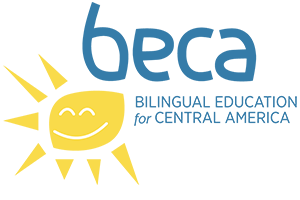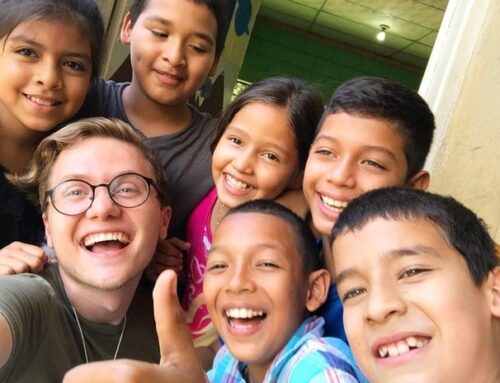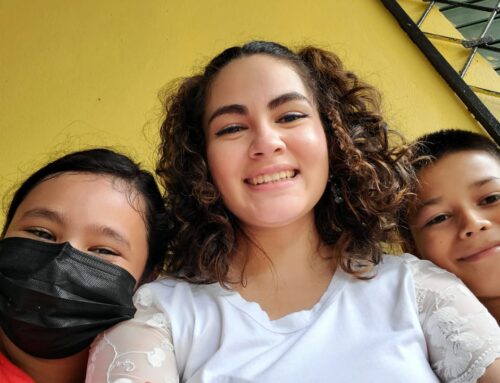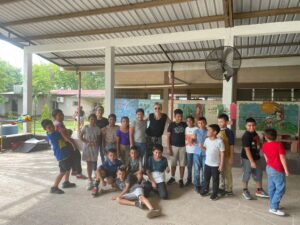
I am not a teacher.
But after two weeks of lesson plans and songs about the days of the week, crafts and word games and more glue sticks than I ever imagined would pass through my sticky hands, I feel a little closer to what “teacher” might mean.
I was lucky enough to join the small crew of volunteers at BECA’s two-week summer camp this year – 2024. To be clear, having a group of 16 children four mornings a week – just eight days – is nothing like being responsible for a school-year-long syllabus and 20 wiggling, eager children for weeks on end. I know this because, while I am not an actual teacher, I am a writer and editor for the national teacher’s union in the U.S., and my work involves getting to know educators and amplifying their stories.
 The difference between talking to teachers and actually teaching is like the difference between listening to someone tell about the thrill of a roller coaster ride, and actually riding it. I got to experience the worry over whether a lesson plan would grab the kids’ attention, or leave them antsy or bored. I felt the thrill of hearing the first audible English words coming from one of the quietest students, and the delight of seeing the most rambunctious child totally absorbed in a book he’d chosen for himself. And I got to do it in a place that is radically different from my everyday life.
The difference between talking to teachers and actually teaching is like the difference between listening to someone tell about the thrill of a roller coaster ride, and actually riding it. I got to experience the worry over whether a lesson plan would grab the kids’ attention, or leave them antsy or bored. I felt the thrill of hearing the first audible English words coming from one of the quietest students, and the delight of seeing the most rambunctious child totally absorbed in a book he’d chosen for himself. And I got to do it in a place that is radically different from my everyday life.
Here is the truth: This is a selfish story. Of course I want to contribute to a project I believe in. BECA is changing lives in so many ways, and has been doing it for 23 years. You can read about that elsewhere on this website. And yes, I did volunteer my time to encourage and guide children through hours of learning disguised as fun, helping build up their English skills and most of all encouraging their curiosity and a love of learning. Those skills will eventually help build an even more robust community and give them opportunities to reach beyond the confines of low-wage work and poverty that is the experience of so many Hondurans.
All of that is paramount. But also? My personal experience volunteering with BECA expanded my world in ways I never expected.
Visitor or volunteer?
 My days in Cofradía were equal parts volunteer and visitor, experiencing a new place for the first time. I was excited every morning to step out into the streets to walk to school: The mountains surround the town like a rumpled green blanket, making the city a study in contrasts. Tranquil green forest rises above dusty, rutted roads roaring with motorcycles and “mototaxis”–motorcycles ingeniously re-rigged with seats to take passengers on short trips around town. Early morning birdsong lilts across a patchwork of corrugated rooftops, slips of laundry hang across patios and dirt yards and I wonder whether they are dust-coated and dirtier than when they were first hung up by the time they are dry. Mango trees are ripe with fruit so abundant it litters the ground, and ragged dogs eat from overflowing trash bags at the side of the road.
My days in Cofradía were equal parts volunteer and visitor, experiencing a new place for the first time. I was excited every morning to step out into the streets to walk to school: The mountains surround the town like a rumpled green blanket, making the city a study in contrasts. Tranquil green forest rises above dusty, rutted roads roaring with motorcycles and “mototaxis”–motorcycles ingeniously re-rigged with seats to take passengers on short trips around town. Early morning birdsong lilts across a patchwork of corrugated rooftops, slips of laundry hang across patios and dirt yards and I wonder whether they are dust-coated and dirtier than when they were first hung up by the time they are dry. Mango trees are ripe with fruit so abundant it litters the ground, and ragged dogs eat from overflowing trash bags at the side of the road.
One of the hallmarks of BECA is its immersion in the community: It is the thing I admire most about this project, as it is truly a reflection of what people in Cofradía want and create for their families–not what a troop of Americans happen to think the community needs.
 The (selfish) bonus for me is that families are so involved, they frequently host teachers and volunteers for meals. We got to spend time with close knit families who live in multigenerational households and pool resources. We ate home-cooked pupusas and baleadas–but more importantly, in informal conversations we learned about how hard it is to secure a teaching job in this country, where positions are few and qualified educators clamor for jobs. We heard stories of husbands gone five years to earn enough to send home and keep the family afloat; of mothers who have not seen their sons in decades. We got to dote over a pet parrot that amiably took turns sitting on our shoulders, we sang happy birthday to a 16-year-old who had been volunteering with us all week, and we played bilingual word games that had us all laughing, across languages and cultures.
The (selfish) bonus for me is that families are so involved, they frequently host teachers and volunteers for meals. We got to spend time with close knit families who live in multigenerational households and pool resources. We ate home-cooked pupusas and baleadas–but more importantly, in informal conversations we learned about how hard it is to secure a teaching job in this country, where positions are few and qualified educators clamor for jobs. We heard stories of husbands gone five years to earn enough to send home and keep the family afloat; of mothers who have not seen their sons in decades. We got to dote over a pet parrot that amiably took turns sitting on our shoulders, we sang happy birthday to a 16-year-old who had been volunteering with us all week, and we played bilingual word games that had us all laughing, across languages and cultures.
Camp time
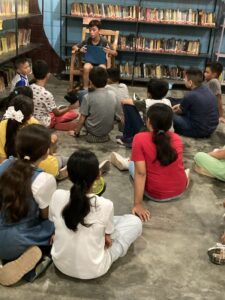 Meanwhile on camp days the children devoured books at the little library and cheered for those who read the most minutes over the course of the week, genuinely excited about reading. They recited greetings in English, drew self-portraits and learned about Mayan engineers–Honduran ancestors–as they fashioned their own “building foundations” from paper. They played hopscotch and chess, red light green light and pirate ship under giant fans in the open-air auditorium. They shared their snacks at recess.
Meanwhile on camp days the children devoured books at the little library and cheered for those who read the most minutes over the course of the week, genuinely excited about reading. They recited greetings in English, drew self-portraits and learned about Mayan engineers–Honduran ancestors–as they fashioned their own “building foundations” from paper. They played hopscotch and chess, red light green light and pirate ship under giant fans in the open-air auditorium. They shared their snacks at recess.
What I learned: To create some structure, but to remain flexible. To look for the good, the generous, the helpful and creative moments among the children, who won stickers for their efforts at the end of each day. To see the intellect and creativity here, the resourcefulness and generosity, the loyalty and love among young friends. To treasure it.
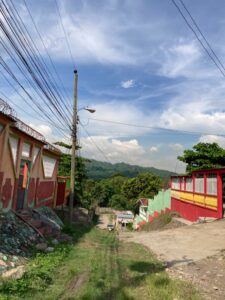 I learned humility. It was especially humbling to realize that not only am I incapable of holding a deep conversation in Spanish, I also stumbled over even the simplest verb agreements and word endings when I talked to my very patient students. I understand as never before what it is like for newcomers in my home country as they try and master English. And I learned that it’s OK not to know all the things, all at once – that learning is its own reward.
I learned humility. It was especially humbling to realize that not only am I incapable of holding a deep conversation in Spanish, I also stumbled over even the simplest verb agreements and word endings when I talked to my very patient students. I understand as never before what it is like for newcomers in my home country as they try and master English. And I learned that it’s OK not to know all the things, all at once – that learning is its own reward.
Most of all, I learned I can do hard things. During stormy evenings, electricity went out. Water was intermittent, so we resorted to “bucket showers.” The heat wasformidable. And keeping children engaged and happy was its own challenge. Together, our little crew did all of it.
Liberación
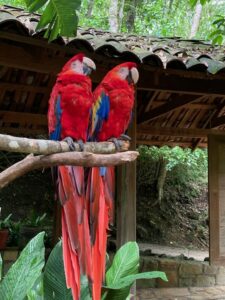 On the weekend, we switched gears and traveled to a town called Copán Ruinas, where we visited Mayan ruins and a sanctuary for guacamayas, or macaws– the brilliantly colored national bird of Honduras. That trip, too, was a study in contrasts. The four-hour bus ride was hot and crowded, but turned out to be one of the highlights of the entire trip: I had a little boy on my lap for much of the ride, and got to chat with his charming mother and grandmother across the aisle. At one point we detoured onto a back road where tropical trees whipped at the windows and we prayed we would not get stuck in the mud as we bumped across a rocky creek in our full-sized bus.
On the weekend, we switched gears and traveled to a town called Copán Ruinas, where we visited Mayan ruins and a sanctuary for guacamayas, or macaws– the brilliantly colored national bird of Honduras. That trip, too, was a study in contrasts. The four-hour bus ride was hot and crowded, but turned out to be one of the highlights of the entire trip: I had a little boy on my lap for much of the ride, and got to chat with his charming mother and grandmother across the aisle. At one point we detoured onto a back road where tropical trees whipped at the windows and we prayed we would not get stuck in the mud as we bumped across a rocky creek in our full-sized bus.
During our time in Copán we witnessed the release of 10 guacamayas into the wild. These birds, either born in captivity or rescued from abusive situations and rehabilitated, had to be socialized to learn how to survive in the wild. When the cage door finally opened, we expected them to fly joyfully away. Instead they all flew as a group to the back of the cage. They tested themselves then, perching near the exit, then flying back to the recesses of the enclosure, learning bit by bit how their boundaries had changed. Finally they began flying out, first one, then two or three, and my heart lifted as I witnessed their freedom. The conservators at the refuge called it “liberación.”
The guacamayas, with their brilliant red plumage and raucous calls, their strong social bonds and high intelligence, weren’t sure of themselves at first. And then, off they went. They did the hard thing and the world was suddenly theirs.

